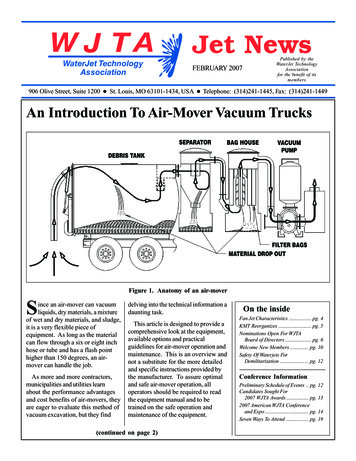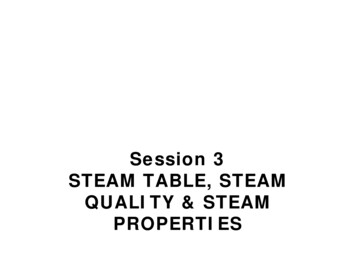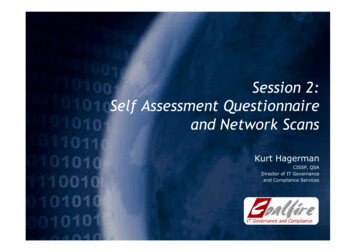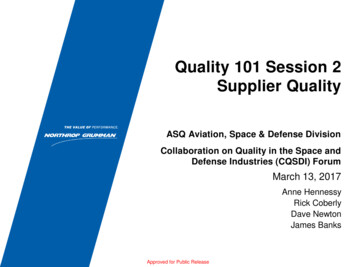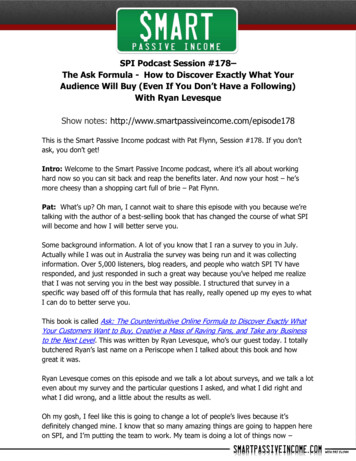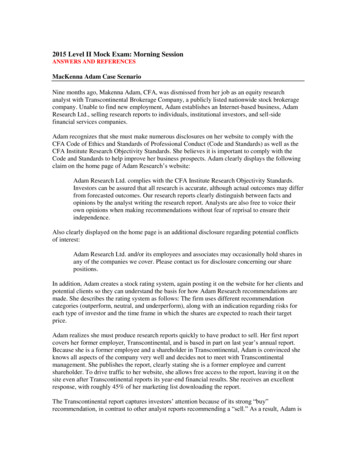
Transcription
Welcome to Session 314Rack Storage – Arriving at Safetyand Fitness – Standards andCertificationPresented by:Sponsored by:Arlin Keck – Steel King IndustriesDaniel Clapp – Frazier Industrial Co.Simon Brain – Wireway/Husky 2012 Material Handling Industry . Copyright claimed as to audiovisual works of seminarsessions and sound recordings of seminar sessions. All rights reserved.
The R-MarkRMI Certification ProcessbyArlin KeckSteel King Industries, Inc.
About the Rack ManufacturersInstitute (RMI) Independent, incorporated non-profitTrade Association Formed in 1958 Mission: To advance standards, quality,and safety in the use of Industrial SteelStorage Rack Products
RMI Members Must control the structural design andmanufacture of storage products made forsale in the USA Pay dues Attend Meetings Participate in a monthly statistical program Voluntarily agree to design rack inaccordance with RMI/ANSI 16.1-2008
Who are RMI Members? Leading manufacturers from the US andother countries Current membership consists of 17Storage Rack companies and 5 Wire Deckassociated members. An up-to-date listing can be found athttp://www.mhia.org/members/directory
What is RMI Certification? Voluntary process Standards based – ANSI-MH16.1- 2008 Independently validated by ProfessionalEngineers outside of the RMI License allowing application by thecompany‟s Registered ProfessionalEngineer
What Does Certification do for theCustomer? Provides independent verification of acompany‟s compliance with the IndustryStandard Ensures that a company knows how tocomply with the current code Differentiates companies that mayotherwise appear similar
How Does a Manufacturer ObtainCertification? Manufacturer conducts component testing Submits test data along with designcalculations and load tables to the RMI Demonstrates compliance with RMI code RMI administers the process and submitsdocuments to two independent P.E.‟s RMI awards an R-Mark license followingapproval of both P.E.‟s
Testing Stub ColumnCantilever TestCyclic Connection TestingDetails later in our presentation
Testing Machine for StubColumns
How to Determine Whether YourRack is Certified R-Mark on Published Load Tables R-Mark on Installation Drawings Visit www.mhia.org/rmi for the latest list ofCompanies with the R-Mark
Frame Capacity Table
Beam Capacity Table
Drawing Sealed with the R-Mark
Specifications, Codes and DesignPracticesbyDaniel ClappFrazier Industrial Company
Why Should I Ask forthe RMI 2008 Specification? Best Design Practice Required by 2009International Building Code Uniform Testing Methods
Best Design Practices Proper accounting for possible columnstrength reduction due to holes.Inclusion of LRFD.Loading combinations including palletloads and proper load factors.Specification of performance of shelfconnection locking device.
Best Design Practices Shelf beam deflection limits.Design requirements for cross-aisle tyingand anchoring.Definition of column design parametersand frame bracing location tolerances.Storage rack seismic design.
Best Design Practices – New for2008 Detailing of Owner‟s Responsibilities.Implementation of the recommendationsfrom FEMA 460.Seismic Design Factors from ASCE 7-05and used in IBC 2009 .Connection rotational capacityrequirements and testing procedures.Inclusion of Pick-Module design.Details of Base Plate & Shimming.
Acceptance by Building Code Storage Rack referenced standard in theInternational Building Code (IBC) 2009
Acceptance by Building Code Uses Seismic DesignCategories– IncludesSeismic Use GroupGround MotionSite Factor– Replaces old “Seismic Zones”
Acceptance by BuildingCode American Society of Civil EngineersASCE-7 05
Acceptance by Building Code International Building Code (IBC) 2009One or more InternationalCodes currently enforcedstate-wideOne or more InternationalCodes currently enforcedwithin state at local tion.htmlAdopted state-wide withFuture enforcement date
Acceptance by Building Code– IBC is the building code adopted in all 50states.– Different states use different IBC editions.– The 2008 RMI Specification has beenincluded by reference, without exceptions,by the ICC for the 2009 InternationalBuilding Code– 2009 IBC is the edition being adopted by thestates
Acceptance by Building Code Seismic Design1. Proper use of building periodapproximations.2. Seismic load distribution when first shelf is12” or less above floor.3. Suggested period determination based onconnection stiffness testing.
Acceptance by Building Code System Identification PlaqueLoad generalities Load Application andRack ConfigurationDrawingsConfiguration Specifics
Uniform Testing Methods Beam-to-column connection test includingseismic cyclical test procedure Stub column test Optional tests– Shelf capacity– Upright frame tests
Uniform Testing Methods Beam-to-column connection test includingseismic cyclical test procedure
Uniform Testing Methods Stub column test
How To Be Sure You ReceiveAn RMI Certified ProductSpecify that all racking components conformto the ANSI/RMI MH16.1-2008 Standardand further require the R-Mark on theCapacity Plaque and the LoadApplication and Rack ConfigurationDrawings.
Introducing R-MarkforWelded Wire DeckSimon Brain, Wireway/Husky Corp
The Wire Deck Industry Group hasjoined theWhy?
Wire Deck & the RMI Generally– Wire Deck was previously part of the IMCWD(Industrial Metal Container & Wire Deck) Groupof the MHIA, but chose to join the RMI becauseWire Deck is almost exclusively an accessoryof Pallet Rack Specifically– To promote consumer education on the safeapplication of Wire Deck– To promote application of the existing WireDeck Standards
Existing StandardANSI MH26.2 Standard
ANSI MH26.2 StandardTesting Principles Wire Deck capacities are based on loadingfrom a „Uniformly Distributed Load‟ Wire Deck testing includes a safety factor of1.67. It does not account for impact loadingor for „point loads‟. This safety factormirrors rack beams
ANSI MH26.2 StandardTesting ProcedureANSI: MH26.2Two Line Load TestDefined testing machinerequirements
ANSI MH26.2 StandardTesting ProcedureThe „two-line‟ load testmethod, with the loadlines placed as shownat the 1st and 3rdquarter points,mathematicallyequates to a„Uniformly DistributedLoad‟ of the samemagnitude
ANSI MH26.2 StandardTesting Procedure Protocol– Load the Deck to allowable deflection (depth/165) andrecord applied load W1 Applied Allowable Load– Load the Deck until structural failure occurs and recordthe applied load W2 Applied Failure Load/2– Deck is rated as the lesser of the two values; W1 orW2– This is equivalent to a safety factor of 1.67 (mirroringrack beams)
ANSI MH26.2 StandardThe Standard applied in Practice
In Practice Wire Deck capacities are based on UniformlyDistributed Loading. Approximately 90% of theload bearing capacity of the Deck is provided bythe supporting channels. Therefore, the ANSI Wire Deck capacity isapplicable to a load base that distributes theload evenly over all of the supporting channelsfor, at minimum, that part of the Deck which issuspended unsupported between the inneredges of the supporting rack structure
In PracticeLoadDistance between inner edges of BeamsShelf Load
In PracticeLoadDistance between inner edges of BeamsPallet Load
In PracticeNon ANSI application of Wire Deck!
The R-MarkSo what’s changing from ANSI MH26.2?
The R-Mark In terms of theoretical and practical applicationof Wire Decks nothing! However. The whole Engineering Standardwill now follow - and be subject to - the RMIindependent verification protocol– Wire deck members of IMCWD Group arenow Associate members of the RMI– The ANSI MH26.2 standard is now the WireDeck R-Mark standard
The R-Mark Most importantly,„voluntary‟ adherence to theIndustry Standard will not be adequate for an RMark – Engineering must be approved byindependent Professional Engineers– Capacity load tables must be approved byindependent Professional Engineers– Material specifications & certifications mustbe approved by independent ProfessionalEngineers
BenefitsThe RMI has a market tested mechanismto level the playing field using approvedEngineering Standards
Benefits The R-Mark allows for consumerconfidence when purchasing welded wirerack decking. The independent PE protocol of the R-Markengenders confidence in the validity of eachmanufacturer‟s certification. Comparing R-Mark products allows for anobjective evaluation of compliant productsfrom certified suppliers.
Consumer ValidationAs a consumer, how can I be sureI receive R-Mark product?
ValidationSame as Rack,look for theR-Mark! the ‘Blue’one in this case
On Load TablesFamily:Step Beam ApplicationsMesh Pattern: 2.5"x4"Mesh Gauge: 6.0 (0.191" - 0.193")Deck Depth 3-chnls(Inches)3Channel Gauge: 13 (0.083"- 0.089")4-chnls 5-chnls 6-chnls 7-chnls 889841,3111,6391,9672,2952,623ASTM A510 / Yield Min 30ksiValidation
Sealed on DrawingsValidation
SuppliersThe leading Manufacturers of WireDeck in the USA are now RMImembers. At this point in time 7companies have submitted for RMark approval.
Specifications AvailabilityANSI MH 16.1-2008ANSI MH 26.2-2007Are available for download fromwww.MHIA.org/RMI
For More Information:www.mhia.org/rmi or p@frazier.comSimonB@wirewayhusky.comVisit MODEX 2012 Booth 5406 2012 Material Handling Industry . Copyright claimed as to audiovisual works of seminarsessions and sound recordings of seminar sessions. All rights reserved.
to the ANSI/RMI MH16.1-2008 Standard and further require the R-Mark on the Capacity Plaque and the Load Application and Rack Configuration Drawings. Introducing R-Mark for Welded Wire Deck Simon Brain, Wireway/Husky Corp . The Wire Deck Industry Group has joined the Why? Generally –Wire Deck was previously part of the IMCWD (Industrial Metal Container & Wire Deck) Group of the MHIA, but .
